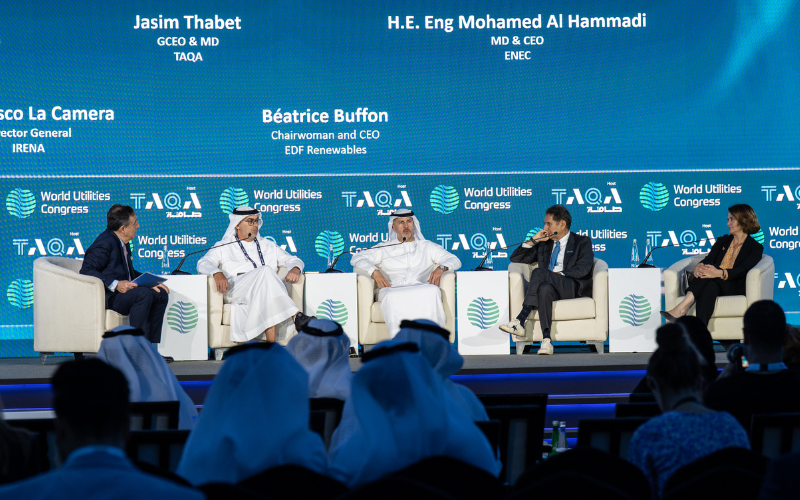HRH Prince Abdulaziz bin Salman Al-Saud
Minister of Energy
Kingdom of Saudi Arabia
Showcase your innovations, elevate your brand, and engage with a global audience - exhibit, visit and sponsor World Utilities Congress to be at the heart of the global utilities transformation.
Join policymakers, business leaders, and innovators to drive real progress, forge partnerships, and shape the future of power and water utilities.
On the exhibition floor, World Utilities Congress provides a dynamic range of opportunities to connect, collaborate, and be inspired.
Go beyond the conference theatres and exhibition floor, World Utilities Congress offers exclusive opportunities to build meaningful connections and forge lasting partnerships across the global utilities community.
Discover a comprehensive collection of insights, official announcements, valuable resources, and high-quality images from the World Utilities Congress.
Prepare for your visit to the World Utilities Congress with essential information designed to help you plan your trip and arrive at the venue seamlessly.
![]()
The World Utilities Congress Strategic Conference unites government officials, policymakers, industry executives, and innovators to drive discussions on transforming the global utilities sector. As electricity demand continues to rise rapidly, the conference focuses on advancing cleaner, lower-carbon power generation and shaping sustainable strategies for water management.
It also highlights the transformative impact of AI and technology in boosting operational efficiency across the sector. By bringing together key decision-makers, the event aims to ensure that record levels of investment in power utilities are balanced with the urgent need to deliver affordable, reliable, and equitable energy access for all.

Sustainable Development Goal 7 (SDG7) aims for affordable, reliable energy for all by 2030. Despite 92% of the global population having basic electricity access, 750 million people still lack it. Policy plays a crucial role in achieving this goal. Strong frameworks drive investment and development, making energy accessible and affordable. Weak policies widen inequalities and slow progress. Coordinated action from governments, regulators, utilities, and innovators is needed to lower costs, close the access gap, and unlock a truly inclusive energy future.
Water scarcity is accelerating beyond the planet’s capacity to meet demand. By 2025, 4.4 billion people will lack access to safe drinking water, and 1.8 billion will face absolute water scarcity. Climate change, population growth, and mismanagement are pushing water systems to the limit. Agriculture uses 70% of freshwater, putting pressure on domestic, industrial, and environmental sectors. To ensure water security, urgent action is needed across governments, utilities, businesses, and communities to strengthen infrastructure, enhance cooperation, and invest in solutions.
Global energy investment will reach USD 3.3 trillion in 2025, with USD 2.2 trillion going to clean energy. Solar will attract the largest share, USD 450 billion. However, grid investment is lagging, threatening energy security. Water networks also need significant upgrades. Many utilities lack the funds to invest in aging infrastructure. To address this, they're exploring alternative financing models. If not addressed, utilities and communities will struggle to upgrade vital infrastructure. The global investment need for water systems is projected to exceed USD 13 trillion over the next decade.
As the world shifts to cleaner energy, utilities must become more resilient. In the Middle East, where demand is growing fast, building resilient energy systems is crucial. A combined approach – efficiency, flexibility, and smart grids – can strengthen utilities. This helps reduce peak loads, ensures reliable power, and balances supply and demand. Empowered customers, with smart meters and digital services, play a key role in enhancing system stability. This blueprint helps policymakers future-proof energy infrastructure for a reliable and sustainable power system.
Renewable energy and water systems necessitate innovative technology. Digital transformation enhances grid efficiency, increases the integration of renewables, and manages demand effectively. In the water sector, it facilitates intelligent distribution, energy-efficient treatment, and leak reduction. Progress in hard technologies, such as solar, wind, energy storage, and desalination, is crucial. Additionally, sensors, AI, and analytics are revolutionising energy and water production. In the water sector, it facilitates intelligent distribution, energy-efficient treatment, and leak reduction. Unlocking the full potential of digitally enabled “new infrastructure” across both sectors requires coordinated action across the value chain, supported by strategic investment, clear policy direction, and strong cross-sector collaboration.
Compute power is becoming an essential resource, driven by the growth of artificial intelligence. By 2030, data centres will require $7 trillion in investment, resulting in an increase in global electricity consumption from 1% to 3%. Addressing this demand calls for action from real estate developers, utilities, semiconductor manufacturers, and cloud providers. Utilities must upgrade grid infrastructure and manage heat densities while also investing in power generation technologies. AI can potentially reduce energy intensity by up to 60% through more efficient energy management. However, the increasing water usage of data centres could put pressure on national water reserves. To ensure sustainable AI growth, we need coordinated efforts in policy, finance, technology, and market development.
The global race to decarbonise is accelerating, yet it risks leaving many behind without a focus on workforce development. The energy and water sectors require advanced digital, technical, and cross-disciplinary skills. However, significant skill gaps remain, particularly in ICT access and digital literacy in the Global South. Attracting and retaining a talented and diverse workforce presents a major challenge. The water sector experiences disparities, especially in engineering and operations, where women and underrepresented groups encounter systemic barriers. Women represent 39% of the global workforce but only 20% of the energy sector, which hampers innovation. Academic institutions must collaborate to create a pipeline of future talent for the energy and water workforce. Addressing the talent gap requires focused programmes, inclusive hiring practices, and robust mentorship. Involving young people in a just transition is crucial for climate resilience and meeting global objectives. are yielding positive outcomes, enhancing female participation in energy sectors. A diverse workforce is key to fostering innovation and ensuring a resilient future.
The energy transition encompasses both governance and technology. By 2025, more than 60 nations will have implemented integrated energy policies that balance economic growth with climate commitments. These policies increasingly incorporate water security and sustainable resource management. Reforms are centred on transparency, accountability, and inclusive decision-making. Regulations are evolving towards market reforms, gender inclusion, and diversity. Policy efforts are aligning water, energy, and climate initiatives. While some regions may temporarily relax fossil fuel policies, the long-term objective remains clear: inclusive governance and equitable policy frameworks are essential for a cleaner, fairer energy future.
Minister of Energy
Kingdom of Saudi Arabia
Minister of Energy & Infrastructure
UAE
Minister of Electricity and Water Affairs
Kingdom of Bahrain
Minister of Water Resources and Irrigation
Egypt
Minister of Energy
Uzbekistan
Former Minister of Power
Nigeria
Fomer Minister for Economic Affairs
Finland
Minister of Infrastructure and Energy
Albania
Minister of Foreign Affairs and Trade
Hungary
Minister of Agriculture, Rural Development & Environment
Republic of Cyprus
Minister of Energy and Water Resources
Republic of Tajikistan
Minister of Energy
Sri Lanka
Minister of Hydraulics & Sanitation
Mauritania
Former Assistant Secretary, Office of Nuclear Energy, Department of Energy
United States of America
Deputy Minister of Energy
Azerbaijan
Minister of Planning and Development Prime Minister's Office
Barbados
First Deputy Minister of Economy and Sustainable Development
Georgia
Vice Minister, Ministry of Water Resources
The People’s Republic of China
Minister of Energy and Power Development
Zimbabwe
Chairman
Department of Energy - Abu Dhabi, UAE
Director General of Electricity
Indonesia
Group CEO & MD
TAQA
Secretary General & CEO
World Energy Council
MD & CEO
Emirates Nuclear Energy Company (ENEC)
Group CEO
Emsteel
CEO
Alterra
CEO
28th UN Climate Change Conference of the Parties (COP28)
Director General
International Renewable Energy Agency (IRENA)
Director General
World Nuclear Association (WNA)
Director General
Arab Atomic Energy Agency (AAEA)
Director General
The Energy & Petroleum Regulatory Authority (EPRA)
Director General
Foratom
Secretary General
International Desalination And Reuse Association (IDRA)
Group CEO
South African Nuclear Energy Corporation (NECSA)
Chairman and CEO
EDF
Chairman, President and CEO
Baker Hughes
Former Chairwoman & CEO
SUEZ
Founder & CEO
Octopus Energy Group
CEO
SSE
CEO
Masdar
CEO
Global Wind Energy Council (GWEC)
Founder, Chairman & CEO
ReNew Energy
Founder & CEO
DLO Energy Resources Group Pty Ltd
CEO
Marafiq
CEO
Oman Water & Wastewater Services Company
CEO
Ansaldo Energia
CEO
SWPC
CEO, Asia
JERA
CEO
Net Zero Technology Centre
Co-Founder & President
Zhero
Executive Director
The Mohamed bin Zayed Water Initiative

dmg events is an international exhibition and conference organiser, publisher and information provider to the Energy, Construction, Plastics, Coatings, Manufacturing, Transport, Design and Hospitality industries.
